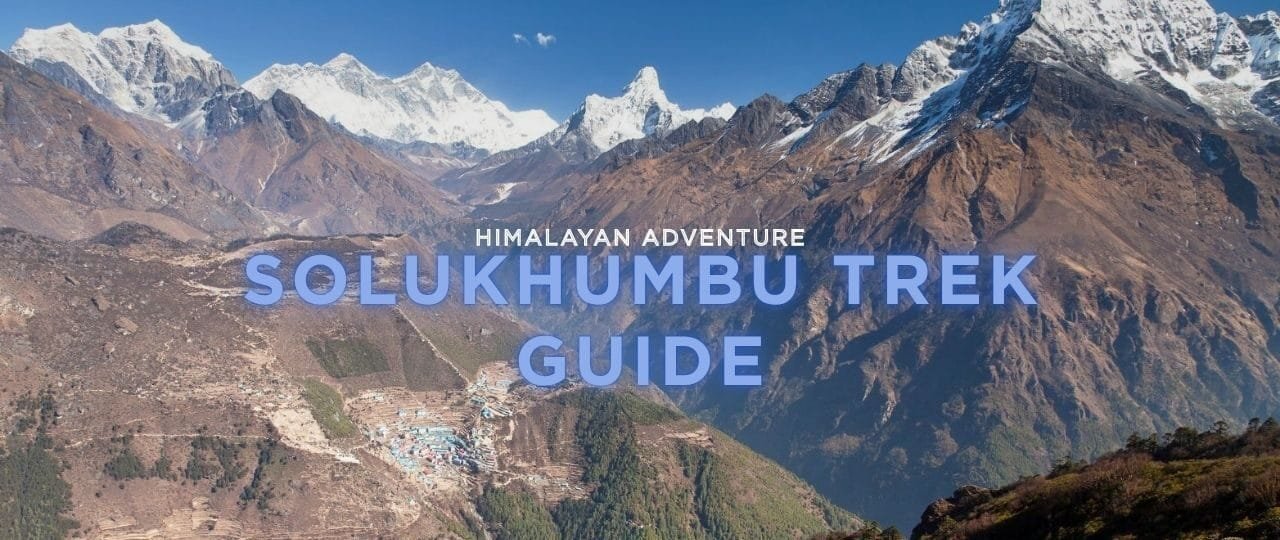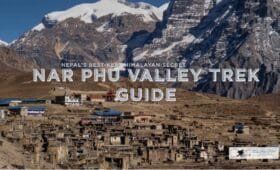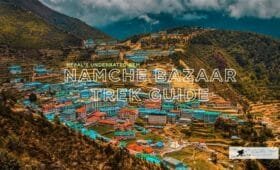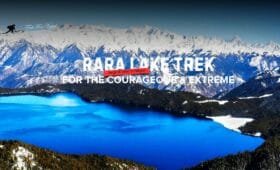The Solukhumbu Trek offers an authentic gateway into the renowned Everest region, fusing spectacular mountain scenery with an immersive cultural tapestry of the Sherpa community. While many trekkers focus solely on Everest Base Camp, Solukhumbu encompasses a broader expanse—lush foothills, sacred monasteries, remote villages, and vantage points that reveal rugged landscapes carved by glaciers. If you crave a less commercialized route yet still dream of glimpsing Everest’s grandeur, the Solukhumbu Trek might be your ideal choice.
In this detailed Solukhumbu Trek Guide article, we will dissect everything about the Trek: from the standard Solukhumbu Trek Itinerary and typical Solukhumbu Trek Cost to route planning, best times to visit, difficulty considerations, and how to weave community engagement through Volunteers Initiative Nepal (ViN). Whether you aim to expand your mountaineering resume or relish a moderate trek in the Himalayas, the Solukhumbu Trek highlights the region’s essence without necessarily venturing deep into extreme altitude. Let’s dive into all you need to know.
Introduction
1. Introduction: Why the Solukhumbu Trek?
The Solukhumbu Trek broadens your Himalayan perspective beyond the single-minded goal of reaching Everest Base Camp. Although the region is famously associated with Mount Everest, it hosts numerous alternative trails, vantage points, and Sherpa enclaves that remain off the mainstream radar. Trekkers can choose routes leading to serene yak pastures, Buddhist gompas, or vantage ridges unveiling four of the world’s six highest peaks: Everest, Lhotse, Makalu, and Cho Oyu.
Statistic: According to the Nepal Tourism Board, more than 50,000 foreign trekkers yearly visit the broader Everest region. However, a fraction explores alternative circuits in Solu (the lower part) before ascending into Khumbu. These under-traveled sections brim with farmland, middle-altitude forests, and cultural interludes rarely seen on the direct flight-based approach to Lukla.
Quote:
“The Solukhumbu Trek gave me a holistic Everest region experience. From farmland homestays in lower Solu to glimpses of Everest from moderate altitudes, every day felt genuinely offbeat,” says Aditi, a 33-year-old trekker from India who explored the region last spring.
History
2. Historical & Cultural Overview
Solukhumbu is culturally synonymous with the Sherpa people, who migrated from eastern Tibet centuries ago. Their primary faith—Tibetan Buddhism—manifests in prayer flags, stone mani walls, and ancient monasteries perched on ridges. Although Everest soared to global fame after Sir Edmund Hillary and Tenzing Norgay’s 1953 ascent, local communities in Solukhumbu have nurtured a deep reverence for these mountains for generations, living harmoniously in one of the world’s most demanding terrains.
An official protected region since Sagarmatha National Park’s establishment in 1976, the area’s flora, fauna, and cultural heritage are under conservation. The Solukhumbu Trek route meanders through rhododendron-laden forests, yak-grazing meadows, and possibly vantage ridges near ~4,000 meters. Historically, these trails facilitated commerce, linking Tibetan salt caravans with the Kathmandu Valley and shaping a robust interchange of goods and ideas. Today, teahouses serve the modern influx of trekkers, balancing tradition with evolving tourism demands.
Trek Itinerary
3. Key Highlights of Solukhumbu Trek Itinerary
A standard Solukhumbu Trek Itinerary might span 10–14 days, but much depends on your route preference—some remain in lower Solu for cultural tours, while others advance toward Namche Bazaar. Below is a representative outline:
Day 1: Arrival in Kathmandu (1,350m)
Settle in, meet your guide or trekking agency, and finalize permits. You may also visit UNESCO sites like Boudhanath or Swayambhunath.
Day 2: Drive or Fly to Phaplu (~2,413m)
A scenic 7–8-hour drive or a short flight from Kathmandu. Explore local monasteries in the Phaplu area.
Day 3: Phaplu → Taksindu La (~2,930m) → Ringmo (~2,700m)
Moderately steep trails weave through farmland and pine forests. Taksindu La pass reveals early glimpses of mountainous horizons.
Day 4: Ringmo → Junbesi (~2,700m)
A gentler day crossing small Sherpa villages. Junbesi is famed for its ancient monastery and calm environment.
Day 5: Junbesi → Taktur or Nunthala (~2,200m)
Ascending a moderate ridge. Some days have vantage points for Everest if the weather cooperates.
Day 6–7: Gradual approach to Lukla or Namche
You might eventually join the Lukla–Namche trail, depending on your chosen route. Alternatively, you can remain in lower Solu if you want to focus on local culture.
Day 8–10: Side Trips & Return
Some trekkers push to Namche Bazaar (~3,440m) for iconic Everest glimpses. Others return to Kathmandu from Phakding or Lukla.
Solukhumbu Trek Duration can shift widely. If skipping the flight and starting from Phaplu, anticipate ~10–12 days. Add days if you want a deeper cultural immersion inside villages. Some routes delve into vantage ridges around ~3,800–4,000m for modest Everest views.
Trek Difficulty
4. Understanding the Solukhumbu Trek Difficulty
The Solukhumbu Trek Difficulty is moderate overall, mainly if focusing on lower Solu. However, if forging deeper into Khumbu or climbing to ~4,000m vantage points, expect steeper ascents. Trail conditions include stone steps, forest paths, and suspension bridges. Key challenges:
- Altitude: Some expansions approach ~3,500–4,000m near Namche or vantage ridges.
- Steep Ascents: Taksindu La pass or climbs near Lukla–Namche can test your legs.
- Variable Weather: Rain in monsoon, potential cold in winter, plus Lukla flight uncertainties if you choose that approach.
You can comfortably handle the route with consistent cardio training (running, cycling) and prior multi-day trekking experience. A rest day around Junbesi or near Namche fosters safer acclimatization if going high.
Trek Mapping
5. Mapping Your Route: A Look at the Solukhumbu Trek Map
A well-detailed Solukhumbu Trek Map includes:
- Phaplu (~2,413m): Potential road or flight access from Kathmandu.
- Taksindu La (~2,930m): A scenic pass bridging Solu with the lower reaches of Khumbu.
- Ringmo, Junbesi, Nunthala (~2,200–2,700m): Traditional Sherpa enclaves.
- Lukla (~2,840m): The typical gateway to pivot to standard Everest routes.
- Namche Bazaar (~3,440m): A bustling Sherpa hub for acclimatization or advanced vantage points.
- Potential side vantage (~3,800–4,000m): For partial Everest glimpses if the weather cooperates.
Solukhumbu Trek Route choices vary—some purely revolve around lower Solu while others ascend to Namche or beyond for partial Everest vistas. Confirm your path pre-departure, especially if you want flight-based approaches or advanced vantage climbs.
Trek Costing
6. How Much Does It Cost? Explaining the Solukhumbu Trek Cost
The Solukhumbu Trek Cost can be less than a standard Everest trek. Key expense items:
- Permits:
- If entering the park region, Sagarmatha National Park entry (~USD 30).
- Khumbu Rural Municipality fee (~NPR 2,000, ~USD 17–20) if going beyond Lukla.
- TIMS card (~USD 10–20) if trekking in non-restricted areas.
- Transport:
- Bus to Phaplu (~USD 10–15) or flight (~USD 140–180 each way).
- Jeep from Kathmandu if road conditions allow.
- Food & Teahouse Lodging:
- Teahouses ~USD 5–10 nightly.
- Daily meals ~USD 20–25 for basic dal bhat, noodles, or Sherpa stew.
- Guide / Porter (Optional):
- ~USD 25–30/day for a guide, ~USD 15–25/day for a porter.
- Miscellaneous:
- Hot showers (~USD 2–4).
- Charging electronics (~USD 1–3).
- Wi-Fi or data (~USD 2–5 daily at some teahouses).
A ~10-day itinerary might cost ~USD 500–800 if you go teahouse style with a bus approach. If you want a Solukhumbu Trek Package, including flights, a guide, lodging, and some meals, you might budget ~USD 900–1,300, depending on group size and comfort level.
Booking Trek
7. Booking the Right Solukhumbu Trek Package
A Solukhumbu Trek Package typically addresses:
- Transport: Bus or flight from Kathmandu to Phaplu or Lukla.
- Permits & Paperwork: Freed from local bureaucracy.
- Guide & Porters: Cultural insights, route flexibility, plus altitude safety checks.
- Teahouse Reservations: Useful in peak seasons to guarantee a bed in smaller villages.
When picking an agency, weigh experience in the region, prior references, and how they treat local staff (porters, guides). Solukhumbu Trek Reviews from travelers can highlight reliability, cultural authenticity, or hidden route expansions. Also note if the package includes or excludes your meals, as daily meal costs vary with altitude.
Trek Permits
8. Securing Solukhumbu Trek Permits
Solukhumbu Trek Permits revolve around:
- Sagarmatha National Park (~USD 30) if you head into the park near Lukla or Namche.
- Khumbu Rural Municipality (~NPR 2,000, ~USD 17–20) if crossing certain checkpoints beyond Lukla.
- TIMS: Some local authorities in Khumbu might waive it, but rules can shift—confirm pre-departure.
Keep your passport, visa copies, and 2–3 passport photos handy. The agency typically handles your permits if you buy a Solukhumbu Trek Package. Always carry them in case rangers at trail checkpoints ask for inspection.
Best Timing
9. Solukhumbu Trek Best Time: Seasons & Weather
The Solukhumbu Trek Weather ranges from subtropical foothills to chilly altitudes near 4,000m. The recommended windows:
Monsoon (Jun–Aug): Frequent rains in foothills and cloudy skies hamper mountain vistas. Fewer crowds, lusher farmland, but landslide risk on roads.
Autumn (Sept–Nov): Stable weather, moderate day temps (~15–20°C lower altitudes), clear mountain views, nights near freezing above 3,000m.
Spring (Mar-May): Blooming rhododendrons, comfortable days, occasional afternoon storms. Crisp morning air.
Winter (Dec–Feb): Fewer trekkers, sub-zero nights if heading above 3,500m, though the lower Solu region remains mild. Some teahouses might close in upper ridges.
Trek Guide
10. Hiring a Solukhumbu Trek Guide
A Solukhumbu Trek Guide offers multiple benefits:
- Cultural Understanding: They interpret Sherpa or Rai traditions, bridging language barriers, especially in lesser-known villages.
- Altitude & Safety: A guide can adapt the itinerary if you sense mild sickness. They also coordinate rescue in emergencies.
- Local Economy: Hiring local staff fosters direct community benefits, preserving the region’s intangible heritage.
- Logistical Ease: They handle teahouse booking, route queries, or unexpected weather shifts.
Expect daily guide wages of ~USD 25–30. Some travelers skip guides for well-trodden EBC routes, but lesser-known trails in Solu might require navigation. Also, it’s a more culturally enriching experience.
Tips
11. Preparation & Tips for Success
11.1 Physical Training
- Cardio: Running, cycling, or brisk walking for ~6 weeks prior.
- Strength: Weighted squats, step-ups, or stair climbs replicate daily altitudinal gains.
- Acclimatization: If your route climbs above 3,500m, plan rest or a short day near Junbesi or Namche.
11.2 Gear & Clothing
- Layers: Base layer (thermal), insulating fleece, down jacket, windproof outer shell.
- Footwear: Broken-in trekking boots, comfortable for rocky or muddy paths.
- Essentials: Trekking poles, personal medication kit, water purification tablets, and a sleeping bag at 10 °C for winter or higher altitudes.
11.3 Altitude Strategy
If you remain in lower Solu, Solukhumbu Trek’s Altitude might not exceed 4,000m. Still, watch for mild headaches or dizziness around Taksindu La or vantage ridges. Drink 2–3 liters daily, keep a moderate pace and rest if uneasy.
Testimonials
12. Stories from the Trail: Testimonials & Inspiration
Carla’s Cultural Immersion
Carla, a 28-year-old trekker from Spain, praised the Solukhumbu Trek for letting her. she recalls
“see more than just Everest’s hustle.” She immersed herself in Junbesi’s daily life, visited local monasteries, and learned how yak cheese is crafted. “Every day introduced me to a new snippet of Sherpa heritage,”
Local Perspective
Sonam, a lodge owner near Phaplu, highlights that many skip the flight to Lukla, which benefits lower Solu communities. he says:
“Trekkers on foot purchase supplies, sample local foods, or help sponsor small schooling initiatives. We appreciate this deeper connection,”
FAQs
13. Seven Most Frequently Asked Questions
Below are seven top questions about the Solukhumbu Trek gleaned from search queries and traveler forums:
How long is the Solukhumbu Trek Duration?
It usually takes 10–14 days but can vary from a week (focusing on lower Solu) to 3 weeks if merging with Everest routes.
What is the Solukhumbu Trek Difficulty?
Rated moderate. Lower altitudes are more manageable, but expansions near 3,500–4,000m can be physically challenging.
How much does the Solukhumbu Trek Cost?
If you manage teahouse lodging and a bus/jeep from Kathmandu, expect ~USD 500–800 for ~10 days. A Solukhumbu Trek Package might be ~USD 900–1,300 with flights, a guide, and lodging.
Which Solukhumbu Trek Permits are needed?
Sagarmatha National Park entry (~USD 30) if entering the park, plus the Khumbu Municipality fee (~USD 17–20). A TIMS card will possibly be needed, depending on your route.
When is the Solukhumbu Trek Best Time?
Autumn (Sept–Nov) or spring (March) are the best seasons for mild temperatures, minimal rain, and clear peaks. Winter sees fewer visitors but is colder, and the monsoon is rainy.
Do I need a Solukhumbu Trek Guide?
Advised if you’re venturing lesser-known routes or prefer cultural insights and logistic support. It’s not mandatory on main trails.
How high do we go on the Solukhumbu Trek?
Typically ~3,500–4,000m if crossing Taksindu La or vantage ridges. Lower routes remain ~2,000–3,000m. Some expansions approach Namche (3,440m).
Conclusion
From farmland meadows in lower Solu to the enthralling glimpses of Everest near the edges of Khumbu, the Solukhumbu Trek merges cultural immersion with moderate altitudes and genuine Himalayan charm. Each day underscores the synergy of agriculture, Buddhism, and mountaineering heritage that shapes this region. If you want to see Sherpa life beyond the tourist bustle of Lukla–Everest highways, the Solukhumbu Trek is an enriching option.
Unite Your Trek with Community Empowerment: ViN’s Role
At Volunteers Initiative Nepal (ViN), we believe tourism can seed positive change in local communities. By pairing the Solukhumbu Trek with altruistic projects, you help preserve traditions and foster sustainable growth:
- Share: Encourage your circle—friends, family, or social media networks—to merge adventure with philanthropic goals, forging mindful tourism practices that honor local heritage.
- Volunteer: Dedicate your time to local schools or clinics near Phaplu or Junbesi, bridging skill gaps and fostering cultural exchange.
- Donate: Provide resources that enhance micro-infrastructure or educational supplies, ensuring your presence yields enduring benefits.
- Intern: Conduct field research or implement socio-economic programs that uplift communities in remote Sherpa villages.
Namaste, and let’s carve a future where the Solukhumbu Trek fosters personal conquest and empathetic synergy with Himalayan communities. Together, we can shape a realm where each step resonates as a force for good, preserving these majestic terrains and uplifting their resilient inhabitants.
Additional Info
Deep Dive: Additional Info & Practical Tips
While we’ve outlined the main aspects, these extra notes can refine your Solukhumbu Trek planning, from route expansions to volunteering synergy.
1. Seasonal Weather & Variation
1.1 Autumn (Sept–Nov)
Sunny days, ~15–20°C at lower altitudes, sub-zero at higher vantage ridges. Crisp mountain vistas and heavier teahouse traffic are in synergy with the broader Everest region.
1.2 Spring (Mar-May)
Rhododendrons are in bloom, have moderate temperatures, and have a possibility of late-afternoon thunderstorms. Mornings are typically clear for peak views.
1.3 Winter (Dec–Feb)
Sub-zero conditions above 3,000m at night mean fewer trekkers. Some teahouses in remote areas might close. However, if you can handle the cold, this is good for solitude.
1.4 Monsoon (Jun–Aug)
Rains hamper lower trails and cause flight disruptions if you rely on Lukla. There is lush farmland but limited mountain views. Some advanced travelers enjoy the quiet and greenery.
2. Route Expansions & Combinations
2.1 Extended Approach
If you want a deeper Sherpa immersion, start from Jiri or Shivalaya, bridging lower farmland before ascending to Lukla or Namche. This can add ~5–7 days but reveals authentic rural life.
2.2 Merging with EBC
Enthusiasts with enough time might pivot from Solu to the standard EBC route, increasing the trek length to ~20 days or more.
3. Lodging & Dining
3.1 Teahouses
Solukhumbu Trek Accommodations usually revolve around teahouses with basic twin rooms. Some have shared bathrooms and hot showers for an extra fee (~USD 2–4).
3.2 Food
Anticipate dal bhat (lentil-rice set), mo: mo dumplings, chow mein, plus local specialties. Higher altitudes see more straightforward menus but watch for price increments.
4. Volunteering with ViN
4.1 Pre-/Post-Trek
Volunteers Initiative Nepal can coordinate short stints near Solu villages. Activities include teaching English or hygiene training. Some also choose synergy with local reforestation or women’s empowerment projects.
4.2 Cultural Exchange
Trek-based volunteering can be minimal due to daily movement. However, donating stationery or sponsoring a small library in a local school fosters an immediate positive impact.
5. Potential Warnings
Flight Delays: If you pick Lukla flights, schedule buffer days. Weather unpredictability can cause extended wait times.
Altitude Sickness: Although you may not surpass 4,000m, mild symptoms can occur near passes. Drink water, ascend gradually, and rest if you are unwell.
Road Condition: If you prefer a drive from Kathmandu to Phaplu, expect an unpaved or partially paved route. Seasonal landslides might hamper travel.




